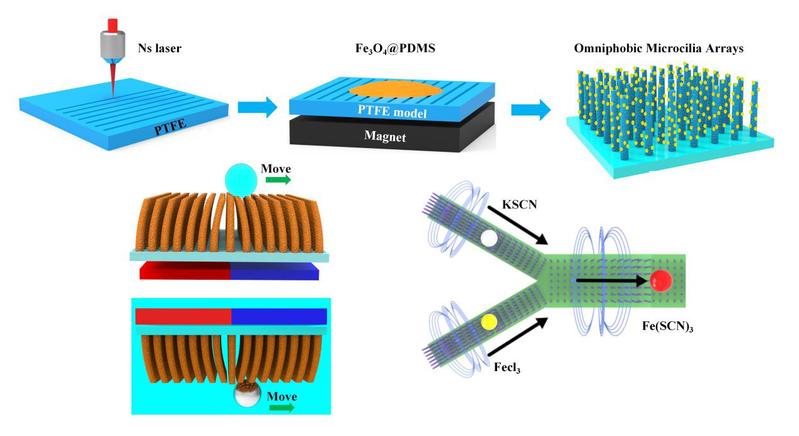Ph.D Candidate Kongbo Wang and Prof. Yongling Wu, published a paper entitled Magnetic-responsive Fe3O4@PDMS@SiO2 Omniphobic Microciliary Arrays for Dynamic Manipulation of Droplets and Spheres (DOI: 10.1016/j.surfin.2023.103487) in Surfaces and Interfaces.
Many biological organ surfaces exhibit unique micro/nano structures, which may be adopted for directional transportation of droplets and spheres for applications in microfluidics, biomedical analysis, chemical reactions and materials research. However, realizing efficient and dynamic manipulation of multi-form substances in different media remains a great challenge. In this study, magnetic-responsive Fe3O4@PDMS@SiO2 omniphobic microciliary arrays (MMAs) are fabricated by combining nanosecond laser machining of PTFE template and transfer replication process. The optimized MMAs with 40 wt% iron oxide content has omniphobic properties with water contact angle > 140°, rolling angle < 3°, and oil contact angle of 129°. Under the stimulation of a moving magnet, microcilia pillars bend and deform sequentially in a wave-like manner, which generates the directional driving force and rapidly transports water and oil droplets, solid spheres and air bubbles in both water and oil media. A droplet up to 25 mL and a solid sphere up to 2 g can be continuously transported at a maximum velocity of 2.4 mm/s. The magnetic field intensity distribution is simulated by COMSOL Multiphysics software, and the force distributions are theoretically calculated. The multi-substances transportation strategy has potential applications in biomedical processes, targeted drug delivery and microfluidics.

Fig. 1 Schematic diagram illustrating the laser preparation of magnetically responsive omniphobic microciliary arrays for dynamic manipulation of droplets and spheres.


